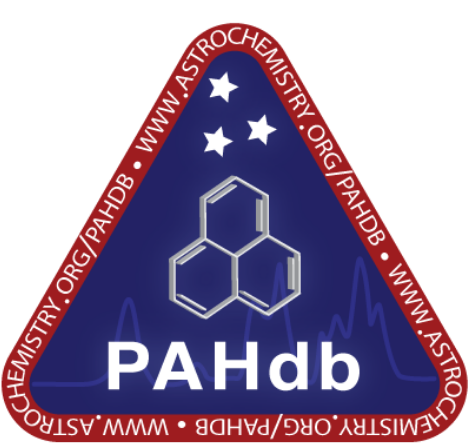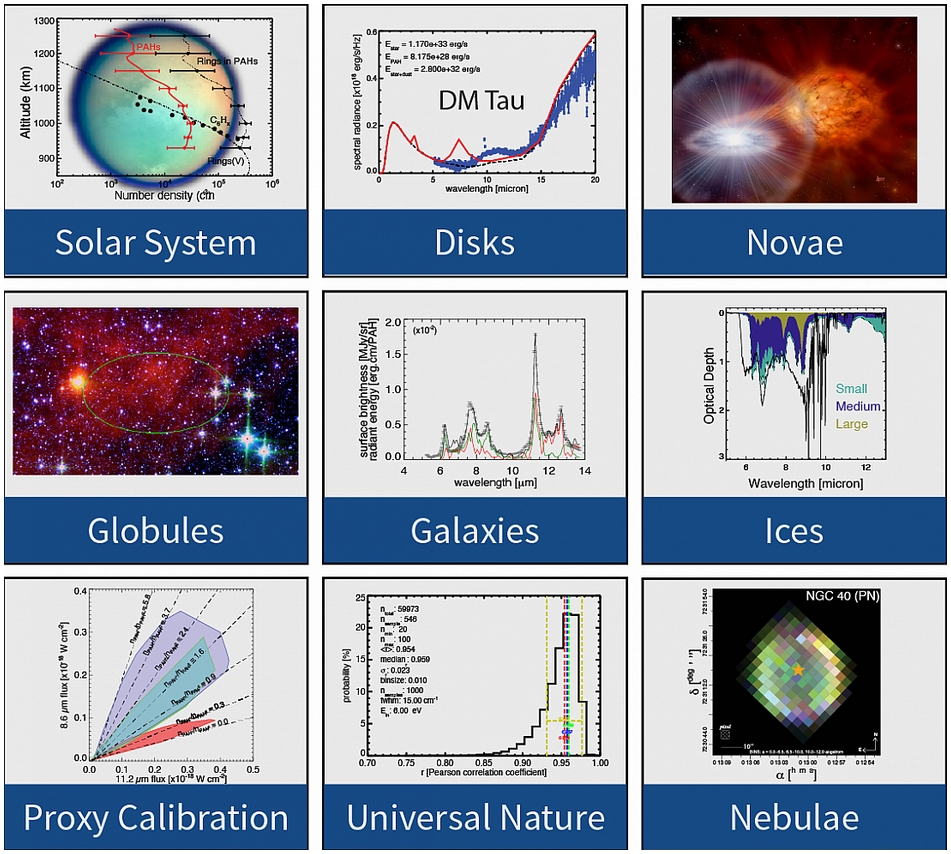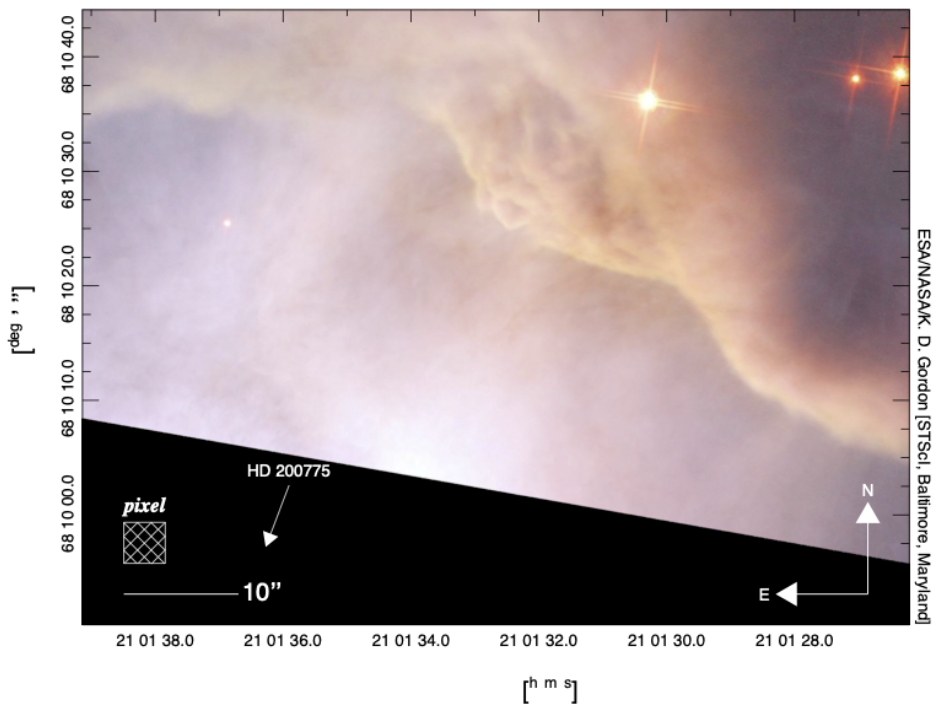Members: Christiaan Boersma, Lou Allamandola, Jesse Bregman, Andrew Mattioda, Charlie Bauschlicher, Alessandra Ricca
Since FY2019 the NASA Ames PAH IR Spectroscopic Database is being supported through a directed Work Package at NASA Ames titled: “Laboratory Astrophysics — The NASA Ames PAH IR Spectroscopic Database”.
The NASA Ames PAH IR Spectroscopic Database
A prominent family of infrared (IR) emission features discovered some thirty-five years ago are now generally attributed to polycyclic aromatic hydrocarbons (PAHs; Figure 2). The features that comprise the apparently universal PAH spectrum (Figure 1) contain a wealth of information about the conditions in the emitting regions and the nature of the PAH carriers.
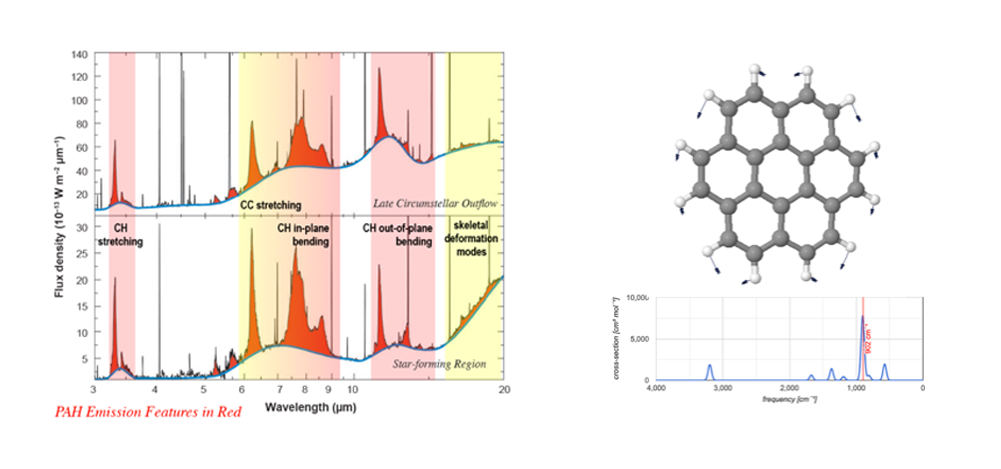
However, the exploitation of these features as astrophysical and astrochemical probes has been slow in coming because the IR properties of PAHs under interstellar conditions were for a long time largely unknown and computational tools needed to provide these data were not yet fully developed.
We generated the data and developed the tools needed to match observed interstellar infrared emission spectra to the spectra of a composition of PAH molecules were developed and produced the NASA Ames PAH IR Spectroscopic Database (PAHdb; Figure 3). A website (www.astrochemistry.org/pahdb/) and several suites of analysis tools allow the scientific community to get the most out of the data available through PAHdb’s spectroscopic libraries (both laboratory-measured and computed). Software suites, available for use with different programming languages, incorporate the models and paradigms we developed to interpret and analyze astronomical observations. This ensures the scientific community has the best tools at hand to make high-impact discoveries. Notably, PAHdb will play a central role in interpreting PAH features in JWST spectra. The contents of PAHdb’s spectral libraries keep expanding and continuous enhancements are made to the analysis tools. Undoubtedly, most JWST observations will contain the PAH features. Whether associated with the object, or as foreground/background confounding features, they will need to be understood, separated from other features, and analyzed for the information they contain.
The content of the database, the website and its accompanying tools have been described in two inaugural papers. The first paper deals with the data obtained through density functional theory, the second with those data obtained through laboratory experiments [1, 2]. The spectroscopic data can be perused and downloaded on the website and the tools with accompanying documentation can be found via the documentation portal.
A significantly updated version of the NASA Ames PAH IR Spectroscopic Database, the first major revision since its release in 2010, was released as version 2.00. Version 2.00 has added laboratory-measured and theoretically computed content, updated (on)offline tools and a totally rewritten website [3]. The library of theoretically computed PAH spectra was updated to version 3.00 in 2018, which saw a dramatic increase in content and introduced the use of multiple scaling factors [4]. The spectroscopic data and tools that make up PAHdb have been used to tackle a plethora of astronomical questions concerning many different types of objects (Figure 4).
Astronomy
One newly developed paradigm utilizing the data and tools in PAHdb is that of spectroscopic database fitting. In a series of three inaugural papers, this approach was laid out by reducing, analyzing and interpreting the Spitzer-IRS spectral map data on the Iris Nebula (Figure 5) [5, 6, 7].
By modeling the PAH emission process, the data in PAHdb is used to synthesize a pool of spectra that are subsequently fitted to the observed PAH spectrum at each pixel position in the spectral map of the Iris Nebula (Figure 6).
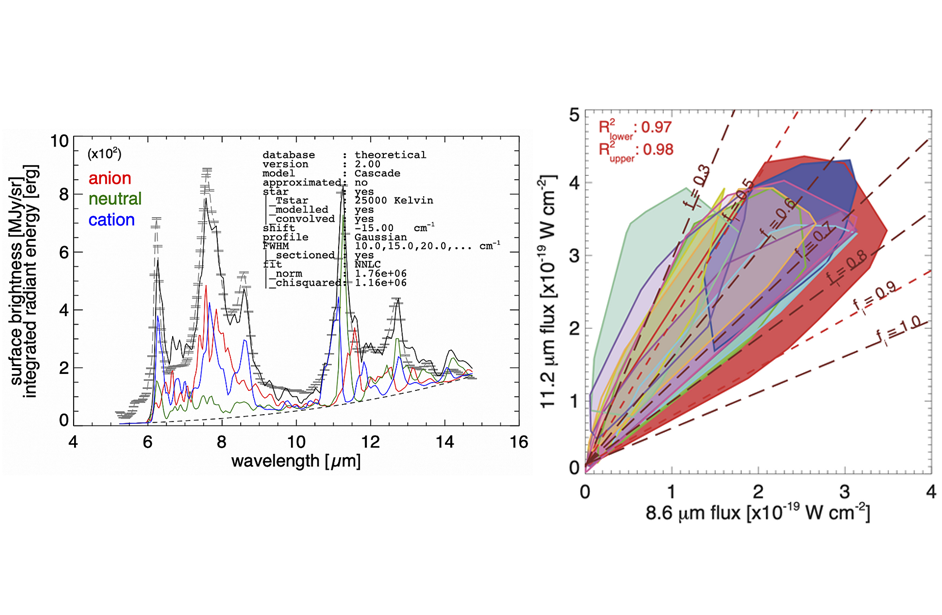
Figure 7 (right): The 11.2 vs. 8.6 μm PAH band strength calibrated for PAH ionization fraction (fi). Each outlined, colored region shows the range for a separate astronomical object. The squared linear relation coefficients for the data defining the lower (Rlower2; lower red short-dashed lines) and upper (Rupper2; upper red short-dashed lines) are limits for the Iris nebula (red region).
Combining the charge breakdown results (Figure 6) with traditional PAH band strength measurements, ratios commonly used as qualitative proxies for PAH charge are now turned into quantitative measures of the PAH ionization fraction (fi), yielding astronomical calibration charts (Figure 7).
References
- C.W. Bauschlicher, Jr., A. Ricca, C. Boersma, L.J. Allamandola, “THE NASA AMES PAH IR SPECTROSCOPIC DATABASE: COMPUTATIONAL VERSION 3.00 WITH UPDATED CONTENT AND THE INTRODUCTION OF MULTIPLE SCALING FACTORS”, The Astrophysical Journal Supplement Series, 234, 32, 2018 10.3847/1538-4365/aaa019
- Mattioda, A. L., Hudgins, D. M., Boersma, C., Ricca, A., Peeters, E., Cami, J., Sánchez de Armas, F., Puerta Saborido, G., Bauschlicher, C. W., J., and Allamandola, L. J. “THE NASA AMES PAH IR SPECTROSCOPIC DATABASE: THE LABORATORY SPECTRA”, The Astrophysical Journal Supplement Series, XXX, XX, 2020 (submitted) XX.XXXX/XXXX-XXXX
- C. Boersma, C.W. Bauschlicher, Jr., A. Ricca, A.L. Mattioda, J. Cami, E. Peeters, F. Sánchez de Armas, G. Puerta Saborido, D.M. Hudgins, and L.J. Allamandola, “THE NASA AMES PAH IR SPECTROSCOPIC DATABASE VERSION 2.00: UPDATED CONTENT, WEBSITE AND ON/OFFLINE TOOLS”, The Astrophysical Journal Supplement Series, 211, 8, 2014 10.1088/0067-0049
- C.W. Bauschlicher, Jr., A. Ricca, C. Boersma, L.J. Allamandola, “THE NASA AMES PAH IR SPECTROSCOPIC DATABASE: COMPUTATIONAL VERSION 3.00 WITH UPDATED CONTENT AND THE INTRODUCTION OF MULTIPLE SCALING FACTORS”, The Astrophysical Journal Supplement Series, 234, 32, 2018 10.3847/1538-4365/aaa019
- C. Boersma, J.D. Bregman, L.J. Allamandola, L.J., “PROPERTIES OF POLYCYCLIC AROMATIC HYDROCARBONS IN THE NORTHWEST PHOTON DOMINATED REGION OF NGC 7023. I. PAH SIZE, CHARGE, COMPOSITION, AND STRUCTURE DISTRIBUTION”, The Astrophysical Journal, 2013, 769, 117, 2013 10.1088/0004-637X/769/2/117
- C. Boersma, J. Bregman, L.J. Allamandola, “PROPERTIES OF POLYCYCLIC AROMATIC HYDROCARBONS IN THE NORTHWEST PHOTON DOMINATED REGION OF NGC 7023. II. TRADITIONAL PAH ANALYSIS USING K-MEANS AS A VISUALIZATION TOOL”, The Astrophysical Journal, 795, 110, 2014 10.1088/0004-637X/795/2/110
- C. Boersma, J. Bregman, L.J. Allamandola, “PROPERTIES OF POLYCYCLIC AROMATIC HYDROCARBONS IN THE NORTHWEST PHOTON DOMINATED REGION OF NGC 7023. III. QUANTIFYING THE TRADITIONAL PROXY FOR PAH CHARGE AND ASSESSING ITS ROLE”, The Astrophysical Journal, 806, 121, 2015 10.1088/0004-637X/806/1/121


























